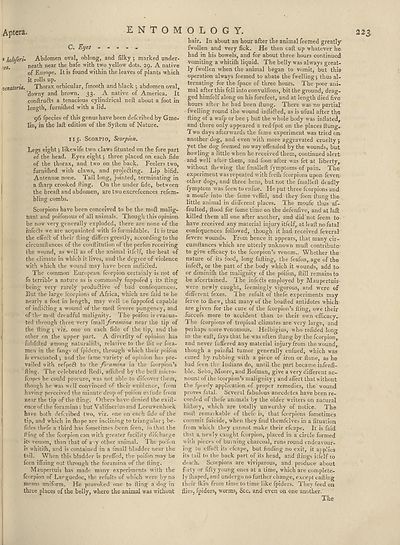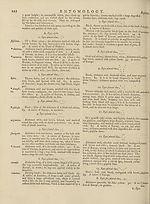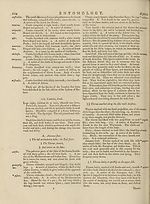Encyclopaedia Britannica, or, a Dictionary of arts, sciences, and miscellaneous literature : enlarged and improved. Illustrated with nearly six hundred engravings > Volume 8, ELE-FOR
(237) Page 223
Download files
Complete book:
Individual page:
Thumbnail gallery: Grid view | List view

ENTOMOLOGY.
Aptera.
C. Eyes
* holoferi- Abdomen oval, oblong, and filky ; marked under-
m neath near the bafe with two yellow dots. 29. A native
of Europe. It is found within the leaves of plants which
it rolls up.
’■enaioria. Thorax orbicular, fmooth and black 5 abdomen oval,
'downy and brown. 33. A native of America. It
conftru&s a tenacious cylindrical neft about a foot in
length, furnilhed with a lid.
96 fpecies of this genus have been defcribed by Gme-
lin, in the lalt edition of the Syftem of Nature.
115. Scorpio, Scorpion.
Legs eight; likewife two claws lituated on the fore part
of the head. Eyes eight j three placed on each lide
of the thorax, and two on the back. Feelers two,
furnilhed with claws, and projecting. Lip bifid.
Antennae none. Tail long, jointed, terminating in
a (harp crooked ding. On the under fide, between
the bread, and abdomen, are two excrefeences refem-
bling combs.
Scorpions have been conceived to be the mod malig-
hant and poifonous of all animals. Though this opinion
be now very generally exploded, there are none of the
infeCts we are acquainted with fo formidable. It is true
the effect of their ding differs greatly, according to the
circumdances of the conditution of the perfon receiving
the wound, as well as of the animal itfelf, the heat of
the climate in which it lives, and the degree of violence
with which the wound may have been infliCted.
The common European fenrpion certainly is not of
fo terrible a nature as is commonly fuppofed j its ding
being very rarely produftive of bad confequences.
Eut the large icorpions of Africa, which are faid to be
nearly a foot in length, may well be fuppofed capable
of inflicting a wound of the mod fevere pungency, and
of the mod dreadful malignity. The poifon is evacua¬
ted through three very fmall foramina near the tip of
the ding •, viz. one on each fide of the tip, and the
other on the upper part. A diverfity of opinion has
fubfided among naturalids, relative to the flit or fora¬
men in the fangs of fpiders, through which their poifon
is evacuated -7 and the fame variety of opinion has pre¬
vailed with refpeft to the foramina in the fcorpion’s
ding. The celebrated Redi, adided by the bed micro-
fcopes he could procure, was not able to difeover them,
though he was well convinced of their exidence, from
having perceived the minute drop of poifon exfude from
near the tip of the ding. Others have denied the exid¬
ence of the foramina; but Valifnerius-and Leeuwenhoek
ha ve both defcribed two, viz. one on each fide of the
tip, and which in fhape are inclining to triangular •, be-
fides thefe a third has fometimes been feen, fo that the
ding of the fcorpion can with greater facility difeharge
its venom, than that of auy other animal. The ppifon
is whitifh, and is contained in a fmall bladder near the
tail. When this bladder is preffed, the poifim may be
feen ifluing out through the foramina of the lling.
Maupertuis has made many experiments with the
fcorpion of Languedoc, the refults of which were by no
means uniform. He provoked one to fiing a dog in
three places of the belly, where the animal w as without
hair. In about an hour after the animal feemed greatly
fwollen and very fick. He then cad up whatever he
had in his bowels, and for about three hours continued
vomiting a whitilh liquid. The belly w as always great¬
ly fwollen when the animal began to vomit, but this
operation always feemed to abate the fwelling; thus al¬
ternating for the fpace of three hours. The poor ani¬
mal after this fell into convuldons, bit the ground, drag¬
ged himfelf along on his forefeet, and at length died five
hours after he had been dung. There w as no partial
fwelling round the wound indieded, as is ufual after the
ding of a wafp or bee ; but the whole body w'as indated,
and there only appeared a red fpot on the places dung.
'I wo days afterwards the fame experiment was tried on
another dog, and even with more aggravated cruelty j
yet the dog feemed no way offended by the w ounds, but
howling a little when he received them, continued alert
and w'ell after them, and foon after was fet at liberty,
without fhewing the fmalled fymptoms of pain. The
experiment was repeated with fredi icorpions upon feven
other dogs, and three hens, but not the fmalled deadly
fymptom was feen to enfue. He put three fcorpions and
a moufe into the fame vcffel, and they foon dung the
little animal in different places. The moufe thus af-
faulted, dood for lome time on the defenfive, and at laft
killed them all one after another, and did not feem to
have received any material injury itfelf, at lead no fatal
confequences followed, though it had received feveral
fevere wounds. From hence it appears, that many cir¬
cumdances which are utterly unknown mud contribute
to give efficacy to the fcorpion’s venom.. Whether the
nature of its food, long fading, the feafon,. age of the
infeft, or the part of the body which it w ounds, add to
or diminiffi the malignity of the poifon, dill remains to
be afeertained. The infefts employed by Maupertuis
were newfly caught, feemingly vigorous, and were ©f
different fexes. I he refult of thefe experiments may
ferve to ftiew, that many of the boafted antidotes which
are given for the cure of the fcorpion’s ding, owe their
fuccefs more to accident than to their own efficacy.
The fcorpions of tropical climates are very large, and
perhaps more venomous. Helbigius, who refided long
in the ead, lays that he was often dung by the fcorpion,
and never differed any material injury from the w ound,
though a painful tumor generally enfued, which was
cured by rubbing with a piece of iron or done, as he
had feen the Indians do, until the part became infenfi-
ble. Seba, Moore, and Bofman, give a very different ac-
nount of the fcorpion’s malignity j and affert that without
the fpeedy application of proper remedies, the wound
proves fatal. Several fabulous anecdotes have been re¬
corded of thefe animals by the older writers on natural
hiitory, which are totally unworthy of notice. The
mod remaikable of thefe is, that fcorpions fometimes
commit filicide, when they find themfelves in a fituation
from which they cannot make their efcape. It is faid
that a newly caught fcorpion, placed in a circle formed
with pieces of burning charcoal, runs round endeavour¬
ing to effeft its efcape, but finding no exit, it applies
its tail to the back part of its head, and dings iifelf to
death. Scorpions are viviparous, and produce about
forty or fifty young ones at a time, which are complete¬
ly fliaped, and undergo no further change, except cading
their Ikin from time to time like fpiders. They feed on
fliesj fpiders, worms, &c. and even on one another.
The
22^
Aptera.
C. Eyes
* holoferi- Abdomen oval, oblong, and filky ; marked under-
m neath near the bafe with two yellow dots. 29. A native
of Europe. It is found within the leaves of plants which
it rolls up.
’■enaioria. Thorax orbicular, fmooth and black 5 abdomen oval,
'downy and brown. 33. A native of America. It
conftru&s a tenacious cylindrical neft about a foot in
length, furnilhed with a lid.
96 fpecies of this genus have been defcribed by Gme-
lin, in the lalt edition of the Syftem of Nature.
115. Scorpio, Scorpion.
Legs eight; likewife two claws lituated on the fore part
of the head. Eyes eight j three placed on each lide
of the thorax, and two on the back. Feelers two,
furnilhed with claws, and projecting. Lip bifid.
Antennae none. Tail long, jointed, terminating in
a (harp crooked ding. On the under fide, between
the bread, and abdomen, are two excrefeences refem-
bling combs.
Scorpions have been conceived to be the mod malig-
hant and poifonous of all animals. Though this opinion
be now very generally exploded, there are none of the
infeCts we are acquainted with fo formidable. It is true
the effect of their ding differs greatly, according to the
circumdances of the conditution of the perfon receiving
the wound, as well as of the animal itfelf, the heat of
the climate in which it lives, and the degree of violence
with which the wound may have been infliCted.
The common European fenrpion certainly is not of
fo terrible a nature as is commonly fuppofed j its ding
being very rarely produftive of bad confequences.
Eut the large icorpions of Africa, which are faid to be
nearly a foot in length, may well be fuppofed capable
of inflicting a wound of the mod fevere pungency, and
of the mod dreadful malignity. The poifon is evacua¬
ted through three very fmall foramina near the tip of
the ding •, viz. one on each fide of the tip, and the
other on the upper part. A diverfity of opinion has
fubfided among naturalids, relative to the flit or fora¬
men in the fangs of fpiders, through which their poifon
is evacuated -7 and the fame variety of opinion has pre¬
vailed with refpeft to the foramina in the fcorpion’s
ding. The celebrated Redi, adided by the bed micro-
fcopes he could procure, was not able to difeover them,
though he was well convinced of their exidence, from
having perceived the minute drop of poifon exfude from
near the tip of the ding. Others have denied the exid¬
ence of the foramina; but Valifnerius-and Leeuwenhoek
ha ve both defcribed two, viz. one on each fide of the
tip, and which in fhape are inclining to triangular •, be-
fides thefe a third has fometimes been feen, fo that the
ding of the fcorpion can with greater facility difeharge
its venom, than that of auy other animal. The ppifon
is whitifh, and is contained in a fmall bladder near the
tail. When this bladder is preffed, the poifim may be
feen ifluing out through the foramina of the lling.
Maupertuis has made many experiments with the
fcorpion of Languedoc, the refults of which were by no
means uniform. He provoked one to fiing a dog in
three places of the belly, where the animal w as without
hair. In about an hour after the animal feemed greatly
fwollen and very fick. He then cad up whatever he
had in his bowels, and for about three hours continued
vomiting a whitilh liquid. The belly w as always great¬
ly fwollen when the animal began to vomit, but this
operation always feemed to abate the fwelling; thus al¬
ternating for the fpace of three hours. The poor ani¬
mal after this fell into convuldons, bit the ground, drag¬
ged himfelf along on his forefeet, and at length died five
hours after he had been dung. There w as no partial
fwelling round the wound indieded, as is ufual after the
ding of a wafp or bee ; but the whole body w'as indated,
and there only appeared a red fpot on the places dung.
'I wo days afterwards the fame experiment was tried on
another dog, and even with more aggravated cruelty j
yet the dog feemed no way offended by the w ounds, but
howling a little when he received them, continued alert
and w'ell after them, and foon after was fet at liberty,
without fhewing the fmalled fymptoms of pain. The
experiment was repeated with fredi icorpions upon feven
other dogs, and three hens, but not the fmalled deadly
fymptom was feen to enfue. He put three fcorpions and
a moufe into the fame vcffel, and they foon dung the
little animal in different places. The moufe thus af-
faulted, dood for lome time on the defenfive, and at laft
killed them all one after another, and did not feem to
have received any material injury itfelf, at lead no fatal
confequences followed, though it had received feveral
fevere wounds. From hence it appears, that many cir¬
cumdances which are utterly unknown mud contribute
to give efficacy to the fcorpion’s venom.. Whether the
nature of its food, long fading, the feafon,. age of the
infeft, or the part of the body which it w ounds, add to
or diminiffi the malignity of the poifon, dill remains to
be afeertained. The infefts employed by Maupertuis
were newfly caught, feemingly vigorous, and were ©f
different fexes. I he refult of thefe experiments may
ferve to ftiew, that many of the boafted antidotes which
are given for the cure of the fcorpion’s ding, owe their
fuccefs more to accident than to their own efficacy.
The fcorpions of tropical climates are very large, and
perhaps more venomous. Helbigius, who refided long
in the ead, lays that he was often dung by the fcorpion,
and never differed any material injury from the w ound,
though a painful tumor generally enfued, which was
cured by rubbing with a piece of iron or done, as he
had feen the Indians do, until the part became infenfi-
ble. Seba, Moore, and Bofman, give a very different ac-
nount of the fcorpion’s malignity j and affert that without
the fpeedy application of proper remedies, the wound
proves fatal. Several fabulous anecdotes have been re¬
corded of thefe animals by the older writers on natural
hiitory, which are totally unworthy of notice. The
mod remaikable of thefe is, that fcorpions fometimes
commit filicide, when they find themfelves in a fituation
from which they cannot make their efcape. It is faid
that a newly caught fcorpion, placed in a circle formed
with pieces of burning charcoal, runs round endeavour¬
ing to effeft its efcape, but finding no exit, it applies
its tail to the back part of its head, and dings iifelf to
death. Scorpions are viviparous, and produce about
forty or fifty young ones at a time, which are complete¬
ly fliaped, and undergo no further change, except cading
their Ikin from time to time like fpiders. They feed on
fliesj fpiders, worms, &c. and even on one another.
The
22^
Set display mode to:
![]() Universal Viewer |
Universal Viewer | ![]() Mirador |
Large image | Transcription
Mirador |
Large image | Transcription
Images and transcriptions on this page, including medium image downloads, may be used under the Creative Commons Attribution 4.0 International Licence unless otherwise stated. ![]()
| Permanent URL | https://digital.nls.uk/192266500 |
|---|
| Attribution and copyright: |
|
|---|
| Description | Ten editions of 'Encyclopaedia Britannica', issued from 1768-1903, in 231 volumes. Originally issued in 100 weekly parts (3 volumes) between 1768 and 1771 by publishers: Colin Macfarquhar and Andrew Bell (Edinburgh); editor: William Smellie: engraver: Andrew Bell. Expanded editions in the 19th century featured more volumes and contributions from leading experts in their fields. Managed and published in Edinburgh up to the 9th edition (25 volumes, from 1875-1889); the 10th edition (1902-1903) re-issued the 9th edition, with 11 supplementary volumes. |
|---|---|
| Additional NLS resources: |
|

